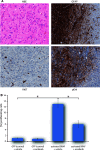MAPK pathway activation in pilocytic astrocytoma
- PMID: 22159586
- PMCID: PMC3350769
- DOI: 10.1007/s00018-011-0898-9
MAPK pathway activation in pilocytic astrocytoma
Abstract
Pilocytic astrocytoma (PA) is the most common tumor of the pediatric central nervous system (CNS). A body of research over recent years has demonstrated a key role for mitogen-activated protein kinase (MAPK) pathway signaling in the development and behavior of PAs. Several mechanisms lead to activation of this pathway in PA, mostly in a mutually exclusive manner, with constitutive BRAF kinase activation subsequent to gene fusion being the most frequent. The high specificity of this fusion to PA when compared with other CNS tumors has diagnostic utility. In addition, the frequency of alteration of this key pathway provides an opportunity for molecularly targeted therapy in this tumor. Here, we review the current knowledge on mechanisms of MAPK activation in PA and some of the downstream consequences of this activation, which are now starting to be elucidated both in vitro and in vivo, as well as clinical considerations and possible future directions.
Figures




References
-
- Cancer Research UK . Statistical report: CancerStats childhood cancer. London: CRUK; 2010.
-
- Central brain tumor registry of the United States . Statistical report: Primary brain and central nervous system tumors diagnosed in the United States 2004–2006. Hinsdale: CBTRUS; 2010.
Publication types
MeSH terms
Substances
LinkOut - more resources
Full Text Sources
Medical
Research Materials

